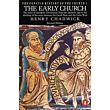The Early Church
Henry Chadwick
Publication Data: New York, NY: Penguin Books, 1993
Format: softcover
Number of Pages: 314
Dimensions (l × w × h): 19.7 cm × 12.9 cm × 1.9 cm
ISBN: 0‒14‒023199‒4
Revised Edition
Henry Chadwick
Volume One of The Penguin History of the Church
“The first Christians were Jews. They differed from their fellow-countrymen by their faith that in Jesus of Nazareth the Messiah of the nation’s expectation had now come. They took it for granted that his coming, being a fulfilment, must be continuous with the past revelation of God to his people and could not mean a break either with the old covenant made with Abraham, symbolized by circumcision, or with the Law given to Moses on Mount Sinai. If something new had happened, it was the action of one and the same God, Creator of the world, Lord of history, the God of Abraham, Isaac, Jacob, and the twelve patriarchs. His new word to his people must be consistent with that spoken in the past by the prophets.”
—“1 From Jerusalem to Rome”
CONTENTS
1 From Jerusalem to Rome
The Jewish background — The earliest Church — The Gentile Church — Encounter with the Roman Empire
2 Faith and Order
The bonds of unity — Gnosticism — The Ministry and the Bible — Forms of the Ministry
3 Expansion and Growth
Causes of success — The geographical extension of the Church — The defence of the Faith
4 Justin and Irenaeus
Justin Martyr — Irenaeus
5 Easter, the Monarchian Controversy, and Tertullian
Easter — The Monarchian Controversy — Tertullian
6 Clement of Alexandria and Origen
Clement of Alexandria — Origen
7 Church, State and Society in the Third Century
The pagan revival and the persecution of Decius — Cyprian — The Great Persecution and its consequences
8 Constantine and the Council of Nicaea
9 The Arian Controversy after the Council of Nicaea
From Nicaea to the death of Constantine — The Church under the sons of Constantine — From Julian to Theodosius I
10 The Conflict of Paganism and Christianity in the Fourth Century
11 Church, State and Society from Julian to Theodosius
12 The Ascetic Movement
13 The Controversy about Origen and the Tragedy of John Chrysostom
14 The Problem of the Person of Christ
Diodore, Theodore, and Apollinaris — Cyril and Nestorius — The ‘Monophysite’ Council of Ephesus and the reaction at Chalcedon — The search for reconciliation — The doctrine of one will
15 The Development of Latin Christian Thought
Jerome and the beginnings of maturity — The conversion of Augustine — The Donatist schism and the problem of coercion — ‘The City of God’ and the Pelagian controversy — The Holy Trinity
16 The Papacy
17 The Church and the Barbarians
18 Worship and Art
Liturgy — Daily offices — Early Church music — Christian art
Conclusion
Suggestions for Further Reading
Format: softcover
Number of Pages: 314
Dimensions (l × w × h): 19.7 cm × 12.9 cm × 1.9 cm
ISBN: 0‒14‒023199‒4
Revised Edition
Henry Chadwick
Volume One of The Penguin History of the Church
“The first Christians were Jews. They differed from their fellow-countrymen by their faith that in Jesus of Nazareth the Messiah of the nation’s expectation had now come. They took it for granted that his coming, being a fulfilment, must be continuous with the past revelation of God to his people and could not mean a break either with the old covenant made with Abraham, symbolized by circumcision, or with the Law given to Moses on Mount Sinai. If something new had happened, it was the action of one and the same God, Creator of the world, Lord of history, the God of Abraham, Isaac, Jacob, and the twelve patriarchs. His new word to his people must be consistent with that spoken in the past by the prophets.”
—“1 From Jerusalem to Rome”
CONTENTS
1 From Jerusalem to Rome
The Jewish background — The earliest Church — The Gentile Church — Encounter with the Roman Empire
2 Faith and Order
The bonds of unity — Gnosticism — The Ministry and the Bible — Forms of the Ministry
3 Expansion and Growth
Causes of success — The geographical extension of the Church — The defence of the Faith
4 Justin and Irenaeus
Justin Martyr — Irenaeus
5 Easter, the Monarchian Controversy, and Tertullian
Easter — The Monarchian Controversy — Tertullian
6 Clement of Alexandria and Origen
Clement of Alexandria — Origen
7 Church, State and Society in the Third Century
The pagan revival and the persecution of Decius — Cyprian — The Great Persecution and its consequences
8 Constantine and the Council of Nicaea
9 The Arian Controversy after the Council of Nicaea
From Nicaea to the death of Constantine — The Church under the sons of Constantine — From Julian to Theodosius I
10 The Conflict of Paganism and Christianity in the Fourth Century
11 Church, State and Society from Julian to Theodosius
12 The Ascetic Movement
13 The Controversy about Origen and the Tragedy of John Chrysostom
14 The Problem of the Person of Christ
Diodore, Theodore, and Apollinaris — Cyril and Nestorius — The ‘Monophysite’ Council of Ephesus and the reaction at Chalcedon — The search for reconciliation — The doctrine of one will
15 The Development of Latin Christian Thought
Jerome and the beginnings of maturity — The conversion of Augustine — The Donatist schism and the problem of coercion — ‘The City of God’ and the Pelagian controversy — The Holy Trinity
16 The Papacy
17 The Church and the Barbarians
18 Worship and Art
Liturgy — Daily offices — Early Church music — Christian art
Conclusion
Suggestions for Further Reading
Write Your Own Review
Frequently Bought Together
-
This Item:
$19.95
-
On the Prayer of Jesus and Divine Grace
$21.75
-
KJV Bible - Black Faux Leather
$25.75
-
Cherry Wood Celtic Cross
$6.25
-
The Complete Illustrated Children's Bible Atlas
$17.25
-
San Ignacio Coffee Whole Bean Medium and Dark Roast 12 oz
$18.00
Total price
Customers Who Bought This Item Also Bought



















